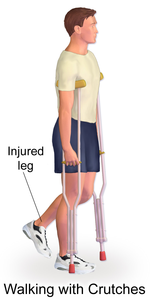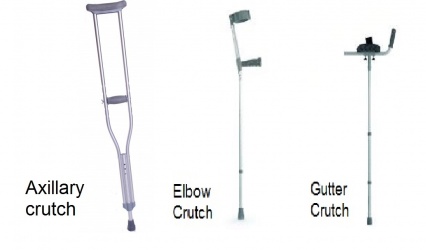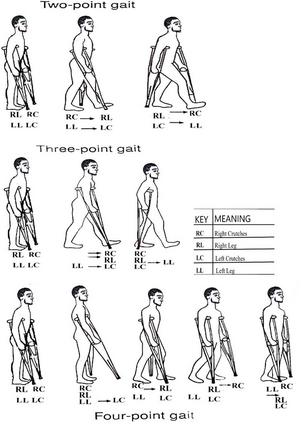Crutches: Difference between revisions
Ahmed Essam (talk | contribs) mNo edit summary |
No edit summary |
||
| (23 intermediate revisions by 9 users not shown) | |||
| Line 1: | Line 1: | ||
<div class="editorbox"> | <div class="editorbox"> | ||
'''Original Editor '''- The [[Open Physio]] project. '''Top Contributors''' - {{Special:Contributors/{{FULLPAGENAME}}}} | '''Original Editor '''- The [[Open Physio]] project. | ||
'''Top Contributors''' - {{Special:Contributors/{{FULLPAGENAME}}}} | |||
</div> | </div> | ||
== Introduction == | == Introduction == | ||
[[File:Crutches Walking.png|right|frameless|300x300px]] | [[File:Crutches Walking.png|right|frameless|300x300px]] | ||
'''Crutches''' are a type of [[Walking Aids]] that serve to increase the size of an | '''Crutches''' are a type of [[Walking Aids|walking aid]] that serve to increase the size of an individual's [[base of support]]. They transfer weight from the legs to the upper body and are often used by people who cannot use their legs to support their weight (from short-term injuries to lifelong disabilities). | ||
== Crutch Type == | == Crutch Type == | ||
There are three types of crutches: axilla crutches, elbow crutches and gutter crutches. | |||
There are three types of crutches | * <u>'''Axilla or underarm crutches:'''</u> They should be positioned with 2 fingers of distance between the axilla and the axilla pad with the elbow flexed between 20-30 degrees.<ref>Hoffman, L. Gait Mobility Devlces Course. Plus. 2022</ref> The design includes an axilla bar, a handpiece and double uprights joined distally by a single leg. They are adjustable in height; both the overall height and handgrip height can be adjusted (adjustable approximately 48 to 60 inches / 12 to 153 cm).<ref name="osulivan">O'Sullivan SB, Schmitz TJ, Fulk G. Physical rehabilitation. FA Davis; 2019 Jan 25.</ref> | ||
* <u>'''Forearm crutches:'''</u> (or lofstrand, elbow or Canadian crutches). Their design includes a single upright, a forearm cuff and a handgrip. The height of forearm crutches is indicated from handgrip to the floor (adjustable from 29 to 35 inches / 74 to 89 cm).<ref name="osulivan" /> | |||
<u>'''Axilla or underarm crutches'''</u> They should | * <u>'''Gutter Crutches:'''</u> (or adjustable arthritic crutches, forearm support crutches) An additional type of crutch, which is composed of a padded forearm support, made up of metal, a strap and adjustable handpiece with a rubber ferrule. These crutches are used for patients who are partial weight bearing, and are particularly useful for clients with rheumatoid conditions.<ref name="gardiner">Gardiner DM. The Principles Of Exercise Therapy, 4th ed. india: CBS Publishers & Distributors; 2004.</ref> | ||
<u>'''Forearm crutches'''</u> | |||
<u>'''Gutter Crutches'''</u> (or adjustable arthritic | |||
[[Image:Types of crutches.jpg|thumb|center|500x250px]] | [[Image:Types of crutches.jpg|thumb|center|500x250px]] | ||
== Measurement == | == Measurement == | ||
It is essential that crutches are measured and adjusted to suit every patient they are given to. While the incidence of adverse events related to crutch use is low, series medical complications can occur.<ref name=":0">Manocha RHK, MacGillivray MK, Eshraghi M, Sawatzky BJ. [https://pubmed.ncbi.nlm.nih.gov/33094912/ Injuries Associated with Crutch Use: A Narrative Review]. PM R. 2021 Oct;13(10):1176-1192.</ref> Adjusting the device to fit the user may reduce adverse events.<ref name=":0" /> | |||
== Walking Pattern == | |||
There are several different walking patterns an individual using crutches may adopt,<ref>Fatemeh Rasouli, Kyle B. Reed. [https://pubmed.ncbi.nlm.nih.gov/31831139/ Walking assistance using crutches: A state of the art review], Journal of Biomechanics. 2020; 98: 1-12</ref> including: | |||
*'''Two-point crutch gait''': Please note the difference between '''two-point gait''' and '''two-point crutch gait'''. In two-point crutch gait, the crutches and the non-weight bearing / affected limb (due to fracture, amputation, joint replacement etc) make up one point and the uninvolved leg makes up the other point. The crutches and affected limb are advanced as one unit, and the uninvolved weight-bearing limb is brought forward to the crutches as the second unit. This gait pattern is less stable as only two points are in contact with floor. Thus, good balance is needed to achieve two-point crutch gait. | |||
*'''Two-point gait:''' the right foot and left crutch are advanced simultaneously, followed by the left foot and right crutch. There are two points in contact with the floor at any one time! | |||
*'''Three-point''': this gait pattern is used when one of the lower extremities (LE) is unable to fully bear weight (due to fracture, amputation, joint replacement etc). There are three points of contact with the floor. The crutches serve as one point, the involved leg as the second point, and the uninvolved leg as the third point. Both crutches move forward, the affected limb then steps up to the crutches. This is followed by the weight-bearing limb which steps through, beyond the crutches. There are always three points of contact with the floor at any given time.<ref>Yap, Wmq et al. “[https://www.ncbi.nlm.nih.gov/pmc/articles/PMC8381660/pdf/moj-15-036.pdf Axillary versus Forearm Crutches: A Prospective Cohort Comparing which is Superior for 3-Point Crutch Gait].” Malaysian orthopaedic journal vol. 15,2 (2021): 36-42.</ref> | |||
*''' | *'''Four-point''': this gait pattern is used when there is a lack of coordination, poor balance and muscle weakness in both LE. This is because it provides a slow and stable gait pattern with four points of support. Point one is the crutch on the involved side, point two is the uninvolved leg, point three is the involved leg, and point four is the crutch on the uninvolved side. The crutches and limbs are advanced separately, with three of the four points on the ground and bearing weight at any given time. <ref name="gardiner" /><ref name="dr das">Van Hook FW, Demonbreun D, Weiss BD. Ambulatory devices for chronic gait disorders in the elderly. American family physician. 2003 Apr 15;67(8):1717-24.</ref>[[File:Ambulatory prescription.png|thumb]] | ||
*''' | *'''Step-to:''' the fractured/injured limb is advanced, and then the intact limb is brought to the same position. When weight-bearing status is restricted to partial, toe-touch, or as tolerated, crutches or a walker are necessary. They help the patient step to the fractured/injured limb by pushing down with the upper extremities, thus transferring weight from the fractured/injured limb to the assistive device. | ||
*''' | *'''Step-through:''' Firstly, the ''fractured/injured leg'' goes forward. Then, the ''intact leg'' is advanced past the injured leg. With restricted weight-bearing, crutches are used instead of the injured limb; the patient steps past the crutches with the weight-bearing lower extremity. Thus, the gait assumes a two-point or three-point pattern. | ||
*''' | {{#ev:youtube|ElZkPye4WtA}} <ref>RegisteredNurseRN .How to Use Crutches .available from :https://www.youtube.com/watch?v=ElZkPye4WtA [Accessed 9 April 2020] </ref> | ||
*''' | |||
{{#ev: | |||
== Indications == | == Indications == | ||
Crutches may be indicated if a patient: | |||
*Has lost the use of a limb (it is either injured or amputated). | *Has lost the use of a limb (it is either injured or amputated). | ||
*Is having problems with [[ | *Is having problems with [[balance]] and impaired strength. | ||
== See also == | == See also == | ||
*[[Canes]] | *[[Canes]] | ||
*[[Walkers]] | *[[Walkers]] | ||
== References == | == References == | ||
<references /> | <references /> | ||
[[Category:Open_Physio]] | [[Category:Open_Physio]] | ||
[[Category:Primary Contact]] | [[Category:Primary Contact]] | ||
[[Category:Assistive | [[Category:Assistive Technology]] | ||
[[Category:Acute Care]] | [[Category:Acute Care]] | ||
[[Category:Course Pages]] | |||
Latest revision as of 10:55, 5 September 2023
Original Editor - The Open Physio project.
Top Contributors - Samrah khan, Kim Jackson, Ahmed Essam, Jess Bell, Rachael Lowe, Larisa Hoffman, Admin, Ammar Suhail, WikiSysop, Redisha Jakibanjar, Lucinda hampton, Laura Ritchie, Naomi O'Reilly, Karen Wilson, Claire Knott, Tolulope Adeniji, Robin Tacchetti and Jorge Rodríguez Palomino
Introduction[edit | edit source]
Crutches are a type of walking aid that serve to increase the size of an individual's base of support. They transfer weight from the legs to the upper body and are often used by people who cannot use their legs to support their weight (from short-term injuries to lifelong disabilities).
Crutch Type[edit | edit source]
There are three types of crutches: axilla crutches, elbow crutches and gutter crutches.
- Axilla or underarm crutches: They should be positioned with 2 fingers of distance between the axilla and the axilla pad with the elbow flexed between 20-30 degrees.[1] The design includes an axilla bar, a handpiece and double uprights joined distally by a single leg. They are adjustable in height; both the overall height and handgrip height can be adjusted (adjustable approximately 48 to 60 inches / 12 to 153 cm).[2]
- Forearm crutches: (or lofstrand, elbow or Canadian crutches). Their design includes a single upright, a forearm cuff and a handgrip. The height of forearm crutches is indicated from handgrip to the floor (adjustable from 29 to 35 inches / 74 to 89 cm).[2]
- Gutter Crutches: (or adjustable arthritic crutches, forearm support crutches) An additional type of crutch, which is composed of a padded forearm support, made up of metal, a strap and adjustable handpiece with a rubber ferrule. These crutches are used for patients who are partial weight bearing, and are particularly useful for clients with rheumatoid conditions.[3]
Measurement[edit | edit source]
It is essential that crutches are measured and adjusted to suit every patient they are given to. While the incidence of adverse events related to crutch use is low, series medical complications can occur.[4] Adjusting the device to fit the user may reduce adverse events.[4]
Walking Pattern[edit | edit source]
There are several different walking patterns an individual using crutches may adopt,[5] including:
- Two-point crutch gait: Please note the difference between two-point gait and two-point crutch gait. In two-point crutch gait, the crutches and the non-weight bearing / affected limb (due to fracture, amputation, joint replacement etc) make up one point and the uninvolved leg makes up the other point. The crutches and affected limb are advanced as one unit, and the uninvolved weight-bearing limb is brought forward to the crutches as the second unit. This gait pattern is less stable as only two points are in contact with floor. Thus, good balance is needed to achieve two-point crutch gait.
- Two-point gait: the right foot and left crutch are advanced simultaneously, followed by the left foot and right crutch. There are two points in contact with the floor at any one time!
- Three-point: this gait pattern is used when one of the lower extremities (LE) is unable to fully bear weight (due to fracture, amputation, joint replacement etc). There are three points of contact with the floor. The crutches serve as one point, the involved leg as the second point, and the uninvolved leg as the third point. Both crutches move forward, the affected limb then steps up to the crutches. This is followed by the weight-bearing limb which steps through, beyond the crutches. There are always three points of contact with the floor at any given time.[6]
- Four-point: this gait pattern is used when there is a lack of coordination, poor balance and muscle weakness in both LE. This is because it provides a slow and stable gait pattern with four points of support. Point one is the crutch on the involved side, point two is the uninvolved leg, point three is the involved leg, and point four is the crutch on the uninvolved side. The crutches and limbs are advanced separately, with three of the four points on the ground and bearing weight at any given time. [3][7]
- Step-to: the fractured/injured limb is advanced, and then the intact limb is brought to the same position. When weight-bearing status is restricted to partial, toe-touch, or as tolerated, crutches or a walker are necessary. They help the patient step to the fractured/injured limb by pushing down with the upper extremities, thus transferring weight from the fractured/injured limb to the assistive device.
- Step-through: Firstly, the fractured/injured leg goes forward. Then, the intact leg is advanced past the injured leg. With restricted weight-bearing, crutches are used instead of the injured limb; the patient steps past the crutches with the weight-bearing lower extremity. Thus, the gait assumes a two-point or three-point pattern.
Indications[edit | edit source]
Crutches may be indicated if a patient:
- Has lost the use of a limb (it is either injured or amputated).
- Is having problems with balance and impaired strength.
See also[edit | edit source]
References[edit | edit source]
- ↑ Hoffman, L. Gait Mobility Devlces Course. Plus. 2022
- ↑ 2.0 2.1 O'Sullivan SB, Schmitz TJ, Fulk G. Physical rehabilitation. FA Davis; 2019 Jan 25.
- ↑ 3.0 3.1 Gardiner DM. The Principles Of Exercise Therapy, 4th ed. india: CBS Publishers & Distributors; 2004.
- ↑ 4.0 4.1 Manocha RHK, MacGillivray MK, Eshraghi M, Sawatzky BJ. Injuries Associated with Crutch Use: A Narrative Review. PM R. 2021 Oct;13(10):1176-1192.
- ↑ Fatemeh Rasouli, Kyle B. Reed. Walking assistance using crutches: A state of the art review, Journal of Biomechanics. 2020; 98: 1-12
- ↑ Yap, Wmq et al. “Axillary versus Forearm Crutches: A Prospective Cohort Comparing which is Superior for 3-Point Crutch Gait.” Malaysian orthopaedic journal vol. 15,2 (2021): 36-42.
- ↑ Van Hook FW, Demonbreun D, Weiss BD. Ambulatory devices for chronic gait disorders in the elderly. American family physician. 2003 Apr 15;67(8):1717-24.
- ↑ RegisteredNurseRN .How to Use Crutches .available from :https://www.youtube.com/watch?v=ElZkPye4WtA [Accessed 9 April 2020]









